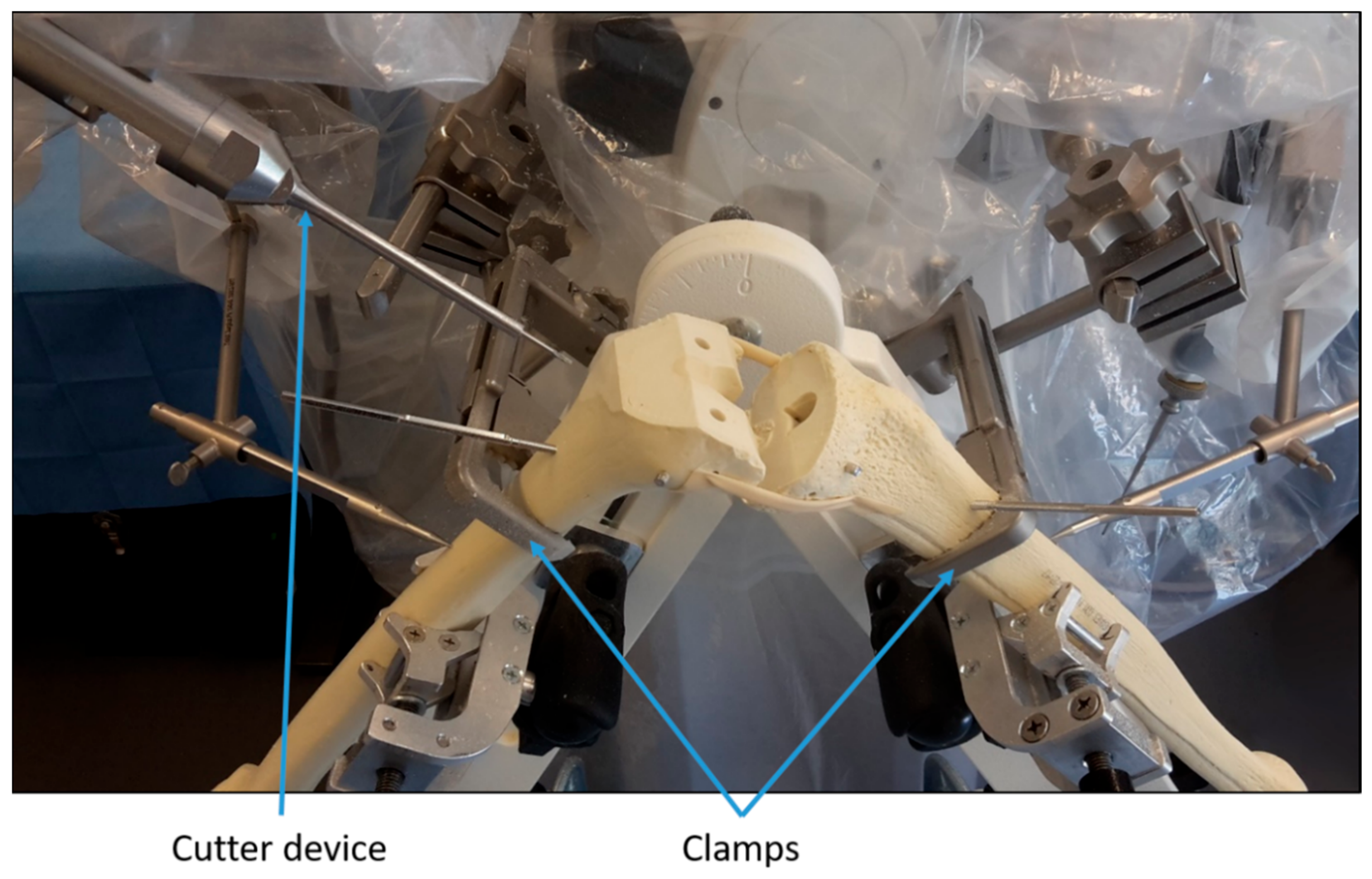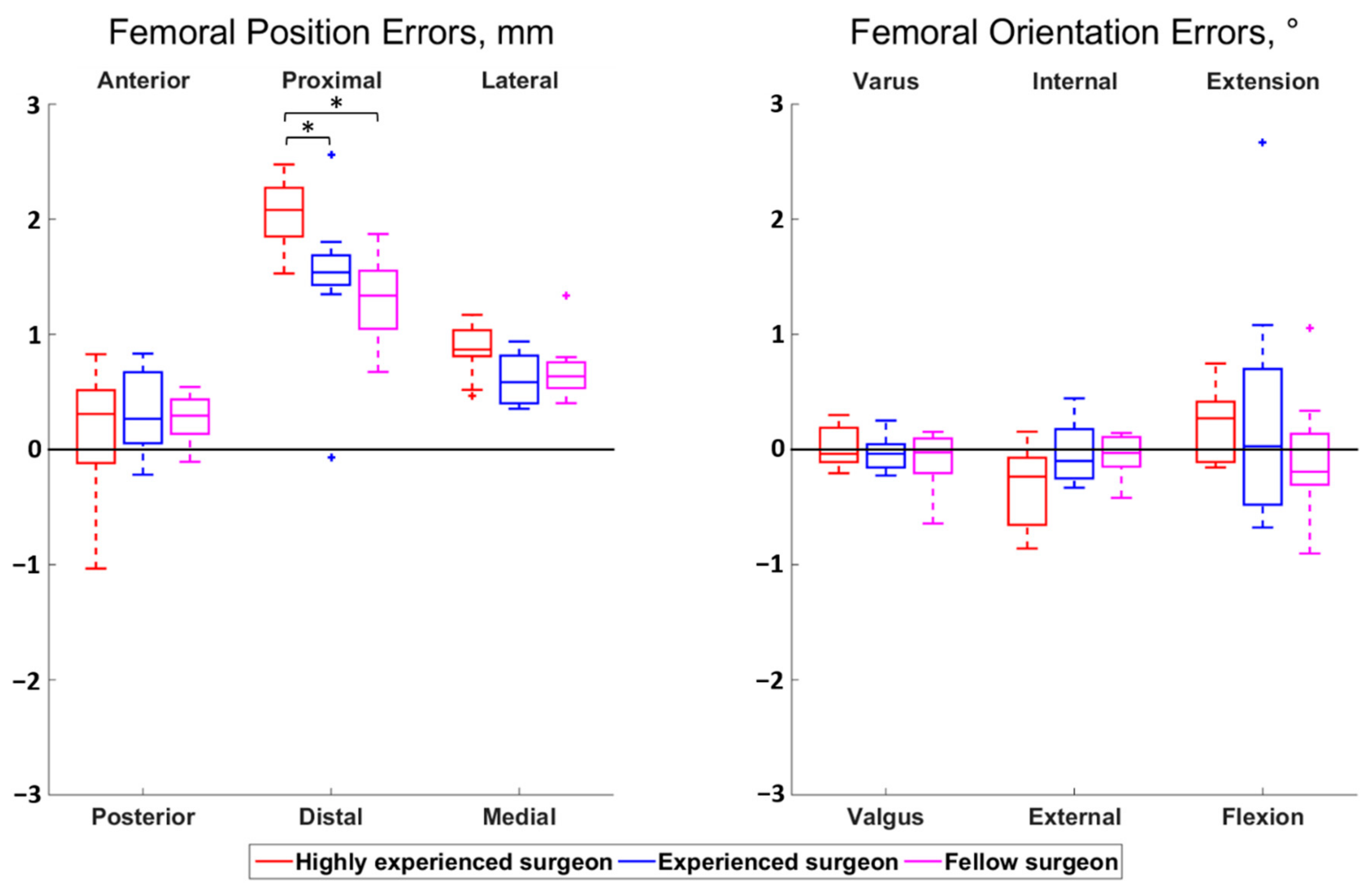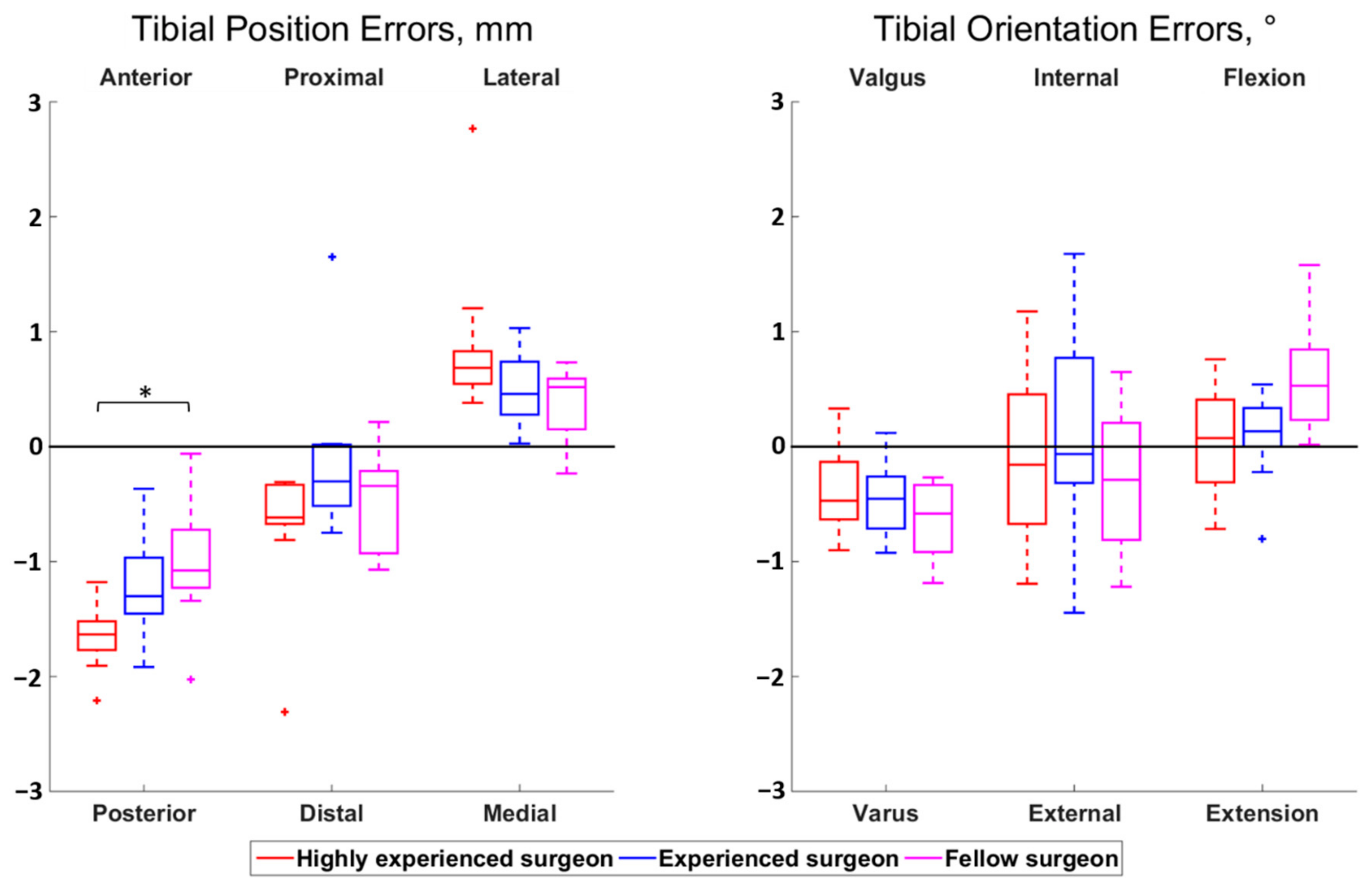Bone Cuts Accuracy of a System for Total Knee Arthroplasty including an Active Robotic Arm
Abstract
:1. Introduction
2. Materials and Methods
2.1. Experimental Setup
2.2. Statistical Analysis
3. Results
3.1. Bone Cut Accuracy Using the Robotic-Assisted System
3.2. Influence of the Surgeon’s Level of Experience
4. Discussion
5. Conclusions
Author Contributions
Funding
Acknowledgments
Conflicts of Interest
References
- Inacio, M.C.S.; Paxton, E.W.; Graves, S.E.; Namba, R.S.; Nemes, S. Projected increase in total knee arthroplasty in the United States—An alternative projection model. Osteoarthr. Cartil. 2017, 25, 1797–1803. [Google Scholar] [CrossRef] [PubMed] [Green Version]
- Bautista, M.; Manrique, J.; Hozack, W.J. Robotics in total knee arthroplasty. J. Knee Surg. 2019, 32, 600–606. [Google Scholar] [CrossRef] [PubMed]
- Jacofsky, D.J.; Allen, M. Robotics in arthroplasty: A comprehensive review. J. Arthroplast. 2016, 31, 2353–2363. [Google Scholar] [CrossRef] [PubMed]
- Anderson, K.C.; Buehler, K.C.; Markel, D.C. Computer assisted navigation in total knee arthroplasty: Comparison with conventional methods. J. Arthroplast. 2005, 20, 132–138. [Google Scholar] [CrossRef] [PubMed]
- Choong, P.F.; Dowsey, M.M.; Stoney, J.D. Does Accurate Anatomical Alignment Result in Better Function and Quality of Life? Comparing Conventional and Computer-Assisted Total Knee Arthroplasty. J. Arthroplast. 2009, 24, 560–569. [Google Scholar] [CrossRef]
- Kazarian, G.S.; Lawrie, C.M.; Barrack, T.N.; Donaldson, M.J.; Miller, G.M.; Haddad, F.S.; Barrack, R.L. The Impact of Surgeon Volume and Training Status on Implant Alignment in Total Knee Arthroplasty. J. Bone Jt. Surg. Am. Vol. 2019, 101, 1713–1723. [Google Scholar] [CrossRef] [Green Version]
- Song, E.-K.; Seon, J.-K.; Yim, J.-H.; Netravali, N.A.; Bargar, W.L. Robotic-assisted TKA reduces postoperative alignment outliers and improves gap balance compared to conventional TKA. Clin. Orthop. Relat. Res. 2013, 471, 118–126. [Google Scholar] [CrossRef] [Green Version]
- Liow, M.H.L.; Goh, G.S.H.; Wong, M.K.; Chin, P.L.; Tay, D.K.J.; Yeo, S.J. Robotic-assisted total knee arthroplasty may lead to improvement in quality-of-life measures: A 2-year follow-up of a prospective randomized trial. Knee Surg. Sport. Traumatol. Arthrosc. 2017, 25, 2942–2951. [Google Scholar] [CrossRef] [PubMed]
- Yang, H.Y.; Seon, J.K.; Shin, Y.J.; Lim, H.A.; Song, E.K. Robotic Total Knee Arthroplasty with a Cruciate-Retaining Implant: A 10-Year Follow-up Study. Clin. Orthop. Surg. 2017, 9, 169–176. [Google Scholar] [CrossRef]
- Sikorski, J.M. Alignment in total knee replacement. J. Bone Jt. Surg. Br. 2008, 90, 1121–1127. [Google Scholar] [CrossRef]
- Allen, M.M.; Pagnano, M.W. Neutral mechanical alignment. Bone Jt. J. 2016, 98-B (Suppl. A), 81–83. [Google Scholar] [CrossRef]
- Omoumi, P.; Babel, H.; Jolles, B.M.; Favre, J. Quantitative regional and sub-regional analysis of femoral and tibial subchondral bone mineral density (sBMD) using computed tomography (CT): Comparison of non-osteoarthritic (OA) and severe OA knees. Osteoarthr. Cartil. 2017, 25, 1850–1857. [Google Scholar] [CrossRef] [Green Version]
- Babel, H.; Wägeli, L.; Sommez, B.; Thiran, J.; Omoumi, P.; Jolles, B.; Favre, J. A registration method for three-dimensional analysis of bone mineral density in the proximal tibia. J. Biomech. Eng. 2020, in press. [Google Scholar] [CrossRef] [PubMed]
- Veldpaus, F.E.; Woltring, H.J.; Dortmans, L.J.M.G. A least-squares algorithm for the equiform transformation from spatial marker co-ordinates. J. Biomech. 1988, 21, 45–54. [Google Scholar] [CrossRef] [Green Version]
- Victor, J.; Van Doninck, D.; Labey, L.; Innocenti, B.; Parizel, P.M.; Bellemans, J. How precise can bony landmarks be determined on a CT scan of the knee? Knee 2009, 16, 358–365. [Google Scholar] [CrossRef] [PubMed] [Green Version]
- Tashiro, Y.; Miura, H.; Matsuda, S.; Okazaki, K.; Iwamoto, Y. Minimally invasive versus standard approach in total knee arthroplasty. Clin. Orthop. Relat. Res. 2007, 463, 144–150. [Google Scholar] [CrossRef] [PubMed]
- Clark, G.; Leong, A.; McEwen, P.; Steele, R.; Tran, T.; Trivett, A. Intra-operative reliability of ShapeMatch cutting guide placement in total knee arthroplasty. Comput. Aided Surg. 2013, 18, 159–165. [Google Scholar] [CrossRef] [Green Version]
- Ohmori, T.; Maeda, T.; Kabata, T.; Kajino, Y.; Iwai, S.; Tsuchiya, H. The Accuracy of Initial Bone Cutting in Total Knee Arthroplasty. Open J. Orthop. 2015, 5, 297–304. [Google Scholar] [CrossRef] [Green Version]
- Antoniadis, A.; Camenzind, R.S.; Schär, M.O.; Bergadano, D.; Helmy, N. Accuracy of tibial cuts with patient-specific instrumentation is not influenced by the surgeon’s level of experience. Knee Surgery Sports Traumatol. Arthrosc. 2019, 27, 1535–1543. [Google Scholar] [CrossRef] [PubMed]
- Parratte, S.; Price, A.J.; Jeys, L.M.; Jackson, W.F.; Clarke, H.D. Accuracy of a new robotically assisted technique for total knee arthroplasty: A cadaveric study. J. Arthroplast. 2019, 34, 2799–2803. [Google Scholar] [CrossRef] [Green Version]
- Hampp, E.L.; Chughtai, M.; Scholl, L.Y.; Sodhi, N.; Bhowmik-Stoker, M.; Jacofsky, D.J.; Mont, M.A. Robotic-arm assisted total knee arthroplasty demonstrated greater accuracy and precision to plan compared with manual techniques. J. Knee Surg. 2019, 32, 239–250. [Google Scholar] [CrossRef] [PubMed]



| Error Type | Median {IQR} | RMS | Percentage of Outliers | Mean ± SD # | ||
|---|---|---|---|---|---|---|
| Femur | Position | Anterior error | 0.29 {0.45} * | 0.45 | 0 | 0.25 ± 0.38 |
| Proximal error | 1.62 {0.49} * | 1.71 | 0 | 1.63 ± 0.55 | ||
| Lateral error | 0.75 {0.35} * | 0.76 | 0 | 0.72 ± 0.25 | ||
| Orientation | Varus error | −0.04 {0.24} | 0.19 | 0 | −0.03 ± 0.19 | |
| Internal rotation error | −0.13 {0.41} | 0.32 | 0 | −0.12 ± 0.30 | ||
| Extension error | 0.03 {0.61} | 0.70 | 0 | 0.14 ± 0.69 | ||
| Tibia | Position | Anterior error | −1.35 {0.58} * | 1.39 | 0 | −1.30 ± 0.50 |
| Proximal error | −0.41 {0.40} * | 0.73 | 0 | −0.43 ± 0.61 | ||
| Lateral error | 0.57 {0.38} * | 0.78 | 0 | 0.60 ± 0.52 | ||
| Orientation | Valgus error | −0.49 {0.44} * | 0.61 | 0 | −0.50 ± 0.36 | |
| Internal rotation error | −0.15 {0.99} | 0.76 | 0 | −0.12 ± 0.77 | ||
| Flexion error | 0.24 {0.51} * | 0.54 | 0 | 0.25 ± 0.48 |
Publisher’s Note: MDPI stays neutral with regard to jurisdictional claims in published maps and institutional affiliations. |
© 2021 by the authors. Licensee MDPI, Basel, Switzerland. This article is an open access article distributed under the terms and conditions of the Creative Commons Attribution (CC BY) license (https://creativecommons.org/licenses/by/4.0/).
Share and Cite
Cosendey, K.; Stanovici, J.; Mahlouly, J.; Omoumi, P.; Jolles, B.M.; Favre, J. Bone Cuts Accuracy of a System for Total Knee Arthroplasty including an Active Robotic Arm. J. Clin. Med. 2021, 10, 3714. https://doi.org/10.3390/jcm10163714
Cosendey K, Stanovici J, Mahlouly J, Omoumi P, Jolles BM, Favre J. Bone Cuts Accuracy of a System for Total Knee Arthroplasty including an Active Robotic Arm. Journal of Clinical Medicine. 2021; 10(16):3714. https://doi.org/10.3390/jcm10163714
Chicago/Turabian StyleCosendey, Killian, Julien Stanovici, Jaad Mahlouly, Patrick Omoumi, Brigitte M. Jolles, and Julien Favre. 2021. "Bone Cuts Accuracy of a System for Total Knee Arthroplasty including an Active Robotic Arm" Journal of Clinical Medicine 10, no. 16: 3714. https://doi.org/10.3390/jcm10163714
APA StyleCosendey, K., Stanovici, J., Mahlouly, J., Omoumi, P., Jolles, B. M., & Favre, J. (2021). Bone Cuts Accuracy of a System for Total Knee Arthroplasty including an Active Robotic Arm. Journal of Clinical Medicine, 10(16), 3714. https://doi.org/10.3390/jcm10163714






